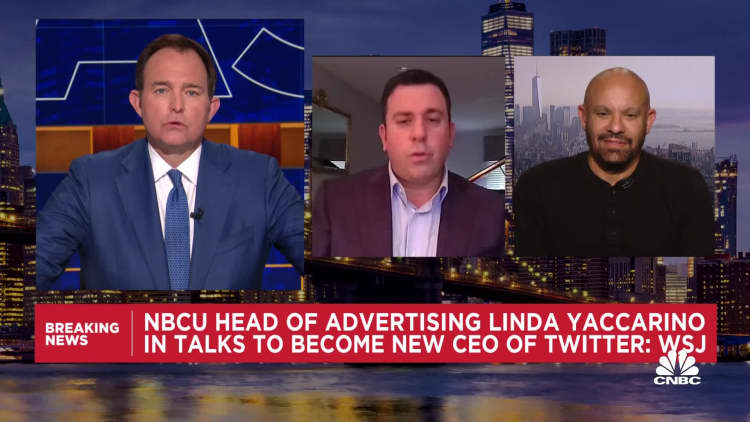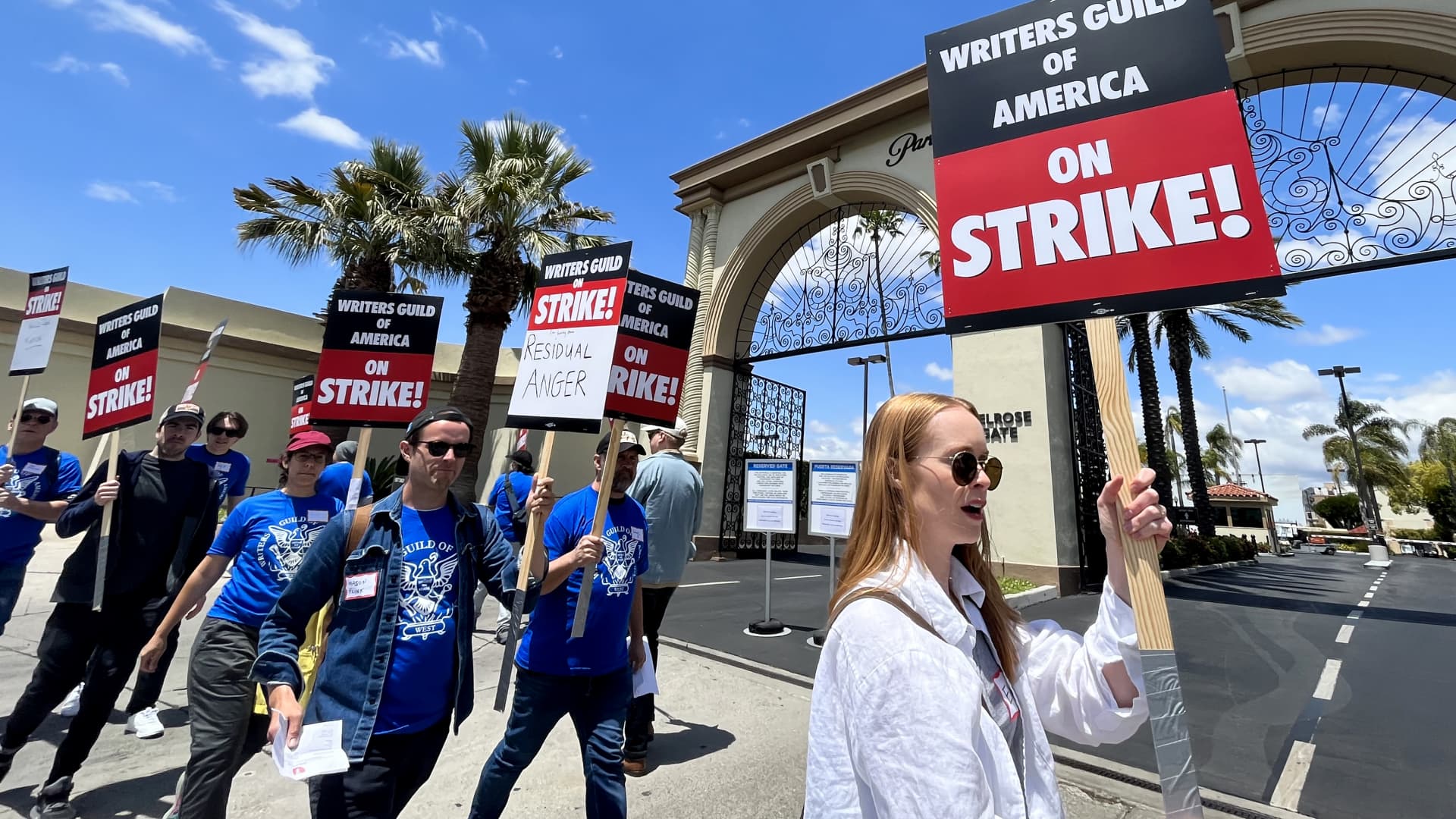Here’s what media giants face as they try to charm advertisers this week
Los Angeles, CA – May 02: WGA members take a selfie before heading to the picket line on the first day of their strike in front of Paramount Studios in Hollywood on May 2, 2023. The union were unable to reach a last minute-accord with the major studios on a new three-year contract to replace one that expired Monday night. (Genaro Molina / Los Angeles Times via Getty Images)
Genaro Molina | Los Angeles Times | Getty Images
Media companies making their pitches to advertisers this week will have to do their best to overcome a lot of noise in the industry.
The advertising market has been soft since last summer, and companies are also cutting costs as they look to make their streaming businesses profitable.
Meanwhile, the Hollywood writers’ strike is sure to play a role in the conversation, especially if picketers show up this week outside the annual advertising sales events known as Upfronts. Some of them already did at the so-called Newfronts, which are similar events focused only on streaming.
Kicking off the week will be Comcast‘s NBCUniversal Upfront, which saw some last minute changes when global ad chief Linda Yaccarino resigned last week before Twitter hired her to replace owner Elon Musk as CEO.
Fox Corp., Disney, Warner Bros. Discovery and newcomer Netflix will also hold events this week. Paramount Global opted out of the Upfronts this year in favor of intimate dinners with advertisers.
Streaming remains a prime topic of discussion, especially as ad-supported tiers have taken on more importance in the face of slowing subscriber growth.
And franchise content is likely to be a big presence as media companies have leaned into series and films with track records for keeping viewers around.
Here’s a look at what’s in store for Upfronts.
Writers’ strike worries
Members of the Writers Guild of America stopped working and headed to the picket lines earlier this month, halting production on films and television shows.
Media executives say the strike will have no immediate effect on programming slates, but that could change depending on how long the strike lasts.
“There are certainly additional elements of fluidity this year, like the WGA strike, that are top of mind for advertisers and make flexibility even more critical in this year’s negotiations,” said Amy Leifer, chief advertising sales officer at DirecTV. “Even if there is a halt of scripted TV production due to the writer’s strike, we know that viewers are still going to consume TV content.”
That will likely mean more emphasis on live content, such as sports and news, if the strike drags on. Fox CEO Lachlan Murdoch said he doesn’t expect his company to be affected by the writers’ strike given its sports and news-heavy slate.
While this helps the traditional media companies like Fox, Warner Bros. Discovery and NBCUniversal, which all have robust sports and news offerings, it could weigh on the entertainment-only networks, as well as streaming services.
A scene from Netflix’ “Stranger Things” Season 4.
Courtesy: Netflix
Already, a number of productions have been paused, including Netflix’s “Stranger Things,” Disney and Marvel’s “Blade,” AppleTV+’s “Severance” and Paramount’s “Evil.”
The immediate concern for Upfronts, however, could be if picketers post up in front of the events. Many of Hollywood’s top talent, especially late-night talk show hosts who have already seen their shows halted, have shown support for the writers. Often, these comedians and talk show hosts take part in Upfronts.
During the Newfronts recently, picketers stood out front of the events. Netflix, which is having its inaugural Upfront this week since it recently instituted an ad-supported tier, has reportedly opted to make its presentation virtual-only.
Soft advertising market
Media executives across the board aren’t as bullish on the advertising market as they were a year ago.
“It feels like a party here,” then-NBCUniversal CEO Jeff Shell said at the Cannes Lions advertising conference last year, held a little more than a month after upfront presentations. “I don’t know if that’s because most of you are out for the first time in a long time or because we’re in the south of France in June, but no, it doesn’t feel like a down market.”
By November, the advertising market collapsed amid surging interest rates and recession fears.
“The advertising market is very weak,” Warner Bros. Discovery CEO David Zaslav in a November investor conference. “It’s weaker than it was during Covid.”
In recent months, executives have noted a limited recovery.
“The overall entertainment advertising marketplace has been challenging,” Disney Chief Financial Officer Christine McCarthy said last week during Disney’s second-quarter earnings conference call. “While the weakness has moderated somewhat, we anticipate that some softness may continue into the back half of the fiscal year.”
NBCUniversal, Paramount Global, Warner Bros. Discovery and Disney all reported dips of between 6% and 15% in TV advertising revenue in the first quarter.
Media executives’ messaging to advertisers could center around value this year, particularly as companies continue to offer more content on their streaming services. Warner Bros. Discovery will showcase Max, its new combined HBO Max-Discovery+ product that launches later this month. Disney announced last week it’s adding a feature to allow Hulu programming within Disney+, a change Chief Executive Bob Iger said “will provide greater opportunities for advertisers” when it rolls out later this year.
Cost cutting
While media executives will try to convince advertisers to maximize their spending, they’ll be pushing that narrative while making fewer shows. Disney said last week it plans to produce less content in the coming year. Warner Bros. Discovery has spent the past year eliminating content from Max to cut costs.
“It’s critical we rationalize the volume of content we’re creating and what we’re spending to produce our content,” Disney’s Iger said.
The cost-cutting efforts are driven by an urgent motivation to make streaming profitable. Paramount Global, NBCUniversal and Disney have all promised streaming will stop losing money by next year. Warner Bros. Discovery said earlier this month its U.S. streaming business will be profitable in 2023 — a year ahead of schedule.
“The key here is our U.S. streaming business is no longer a bleeder,” Zaslav said. “It’s hard to run a business when you have a big bleeder.”
Still, the upfronts are a time to showcase content. If the investor messaging is centered around cutting the fat, the ad buyer message will around showcasing the quality of existing franchises.
Franchise frenzy
If one thing is for certain, the media networks and their streaming counterparts will showcase slates with a heavy emphasis on franchises.
It’s been a theme at Upfronts in recent years. During last year’s NBCUniversal Upfront, late-night host and “Saturday Night Live” alum Seth Meyers made jabs about the schedule of spinoffs and reboots being presented.
“I don’t need to tell you that the last two years have been transformative not just for the TV business but across all industries. We needed to be inventive, agile, forward-facing, and yet and this is still how we are doing upfronts,” Meyers said last year. “That’s not to say that NBC is not embracing the future — this next year promises exciting new shows and ideas like ‘Law & Order,’ ‘The Fresh Prince of Bel-Air,’ ‘Night Court’ and ‘Quantum Leap.'”
Franchises attract a large swath of audience demand for both Hollywood films – which are an important part of the programming slate for streamers like Disney+, Paramount+ and Peacock – as well as TV franchises, according to data from Parrot Analytics.
“Hollywood has been recycling in the last 12 to 13 years as other content has failed to break out,” said Brandon Katz, an entertainment industry strategist at Parrot.
The logo of the streaming service Paramount+ on a logo wall at the Paramount+ launch event. (recrop) The streaming service Paramount+ is now available in Germany.
Jörg Carstensen | Picture Alliance | Getty Images
Paramount, in particular, has seen a big reliance on franchises, especially for its Paramount+ streaming service. Star Trek series content accounted for 32.4% of Paramount+’s U.S. audience demand in 2022, while Yellowstone spinoffs made up 11.4%, according to Parrot.
Last week, Paramount’s CBS broadcast network announced three new series for next season – one being “Matlock,” a reboot of the late 1980s-90s series that will star Academy Award-winning actress Kathy Bates, and the other, “Elisabeth,” which is based on a character from “The Good Wife” and “The Good Fight” franchise.
Disney+ has heavily relied on series stemming from its Marvel and Star Wars libraries. However, Parrot Analytics found there was a downtick in U.S. demand for Marvel content in late 2022, likely due to the mixed reception its recent series have received.
The shift to streaming
Ad-supported streaming will be an even bigger part of the conversation this year.
With cord-cutting accelerating – overall pay-TV subscribers were down 3% this past quarter, “universally worsening,” according to Wells Fargo analyst Steven Cahall – digital advertising is likely to take a bigger piece of the pie.
“It’s a pretty unmistakable trend where linear TV continues to fall and digital video and connected TVs are rising to fill the gap,” said Paul Verna, a principal analyst at Insider Intelligence. Advertisers are expected to spend $12.48 billion on digital media during the Upfronts and Newfronts this year, a 28% increase over last year, Verna added.
U.S. TV ad spending during the Upfronts is expected to drop by 3.6% to $18.64 billion for the 2023-24 season, according to Insider Intelligence, evidence the market has stopped growing on the traditional TV side while more dollars shift toward digital.
Netflix and Disney+ launched ad-supported tiers for their services late last year. With subscriber growth stagnating for streaming, and companies pushing toward streaming profitability, executives hope the cheaper options will retain or bring in customers.
Disney recently said it was relying on its ad-supported option to help make a profit with its streaming offerings. The company will be adding Hulu content to Disney+, which Iger said was “a logical progression of our DTC offerings that will provide greater opportunities for advertisers.”
Price increases for ad-free options, to boost revenue for these businesses, could also push customers to cheaper options with ads.
Paramount+ and NBCUniversal’s Peacock have offered ad-supported tiers since each launched. While Peacock held a Newfront presentation to showcase its content, the streaming service will be a key part of NBCUniversal’s Upfront on Monday.
“Just a year ago, if you looked at the composition of Paramount’s ad revenue, about 25% went to digital,” said David Lawenda, Paramount’s chief digital advertising officer. “Now it’s about 40%. That’s 40 cents of every dollar going to digital.”
Free, ad-supported platforms like Paramount’s Pluto and Fox’s Tubi will also see more advertising dollars come their way.
“We’re looking forward to Tubi being a central part of our upfront negotiations,” Murdoch said recently during Fox earnings. “It’s clearly not only a strategic driver for us. It’s been an important driver going forward.”
These free, ad-supported streaming television, or FAST, services have seen explosive growth. They also experienced an increase in viewership during the height of the pandemic, when productions were halted and there was a lack of new content. If the writers’ strike continues, that could be the case once again.
Disclosure: NBCUniversal is the parent company of CNBC.
WATCH: CNBC”s full interview with MNTN’s Mark Douglas

For all the latest Technology News Click Here

